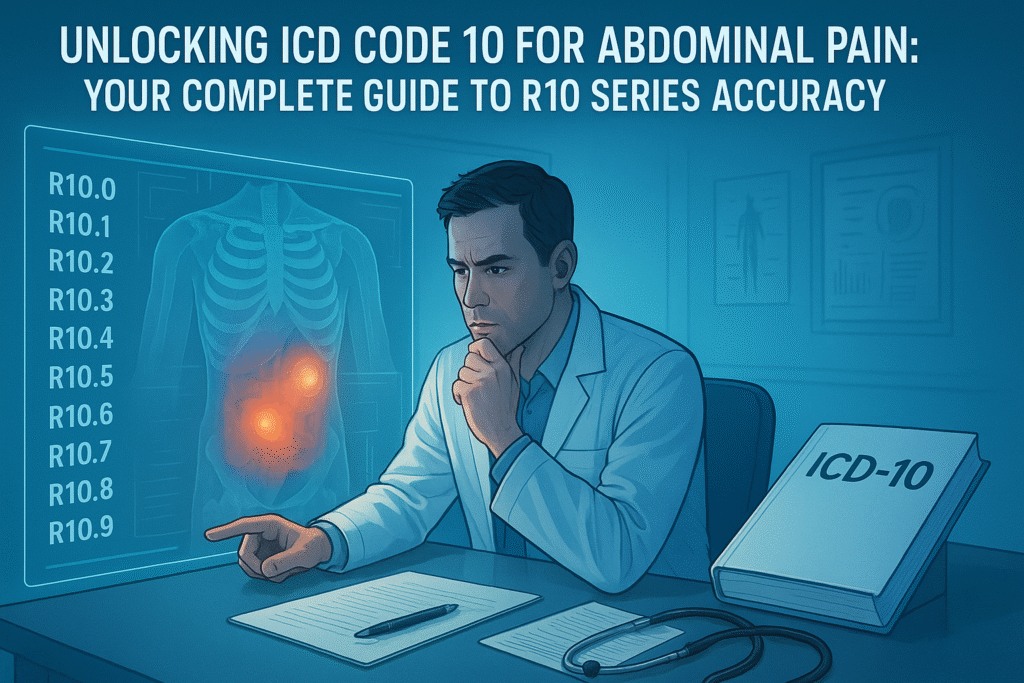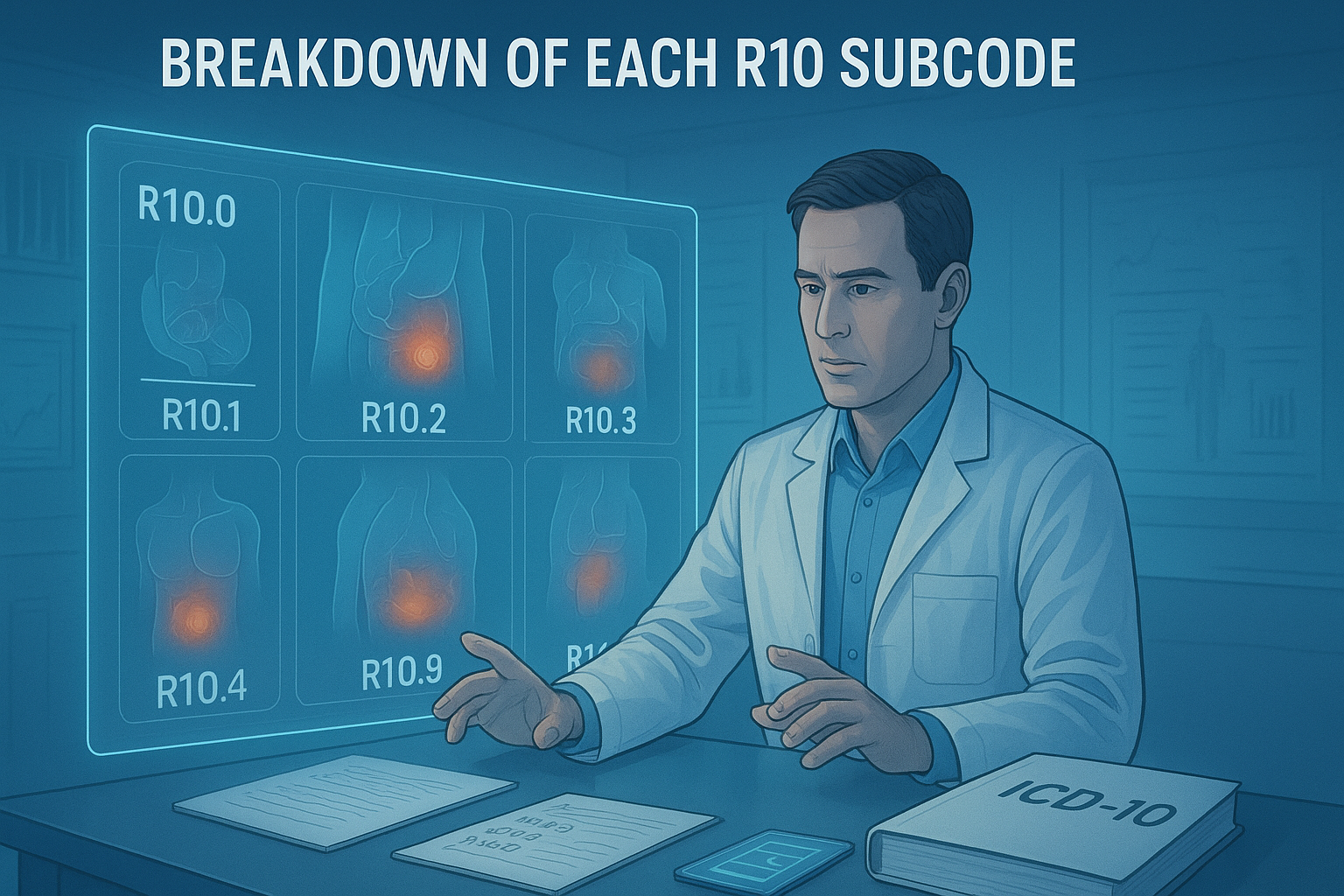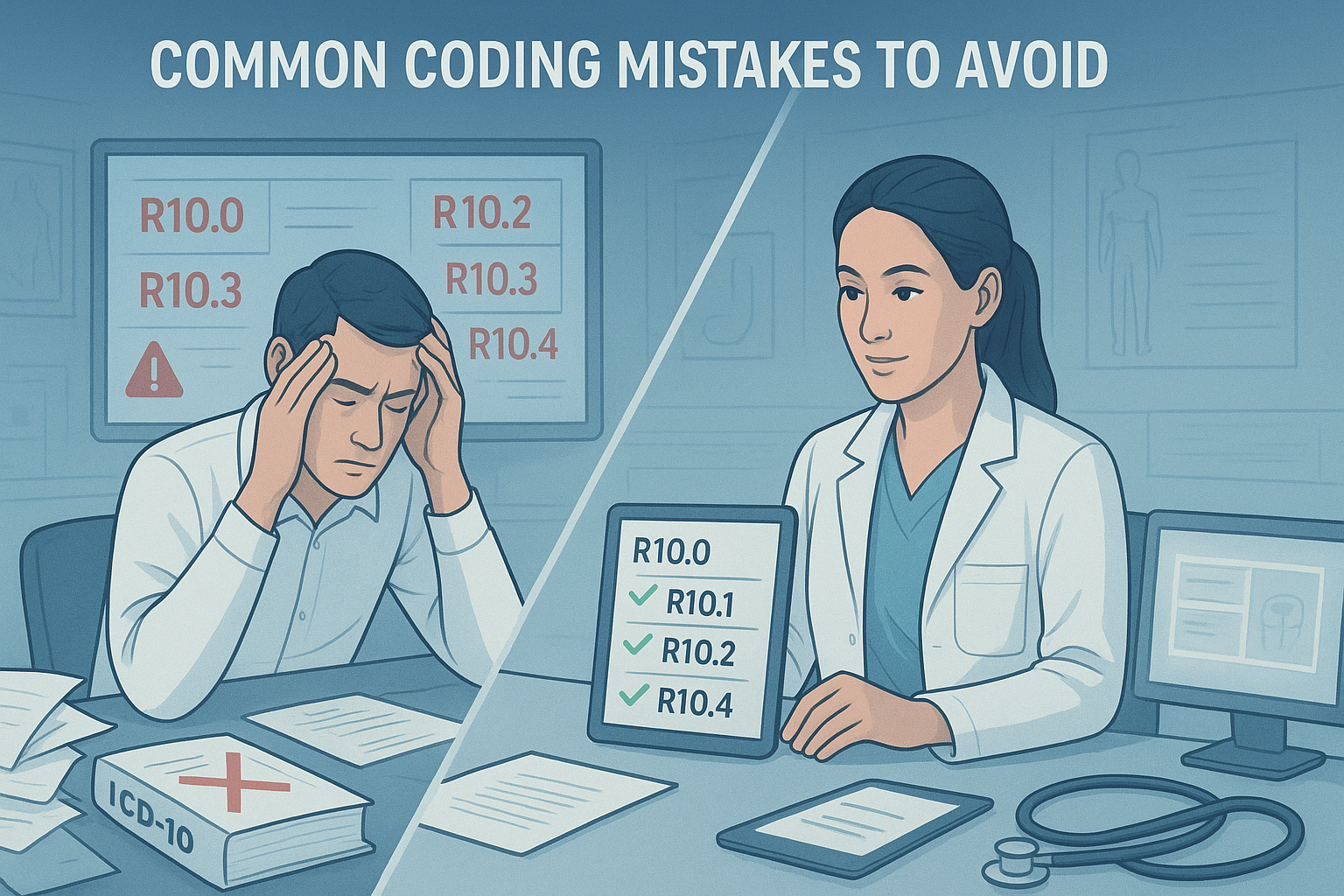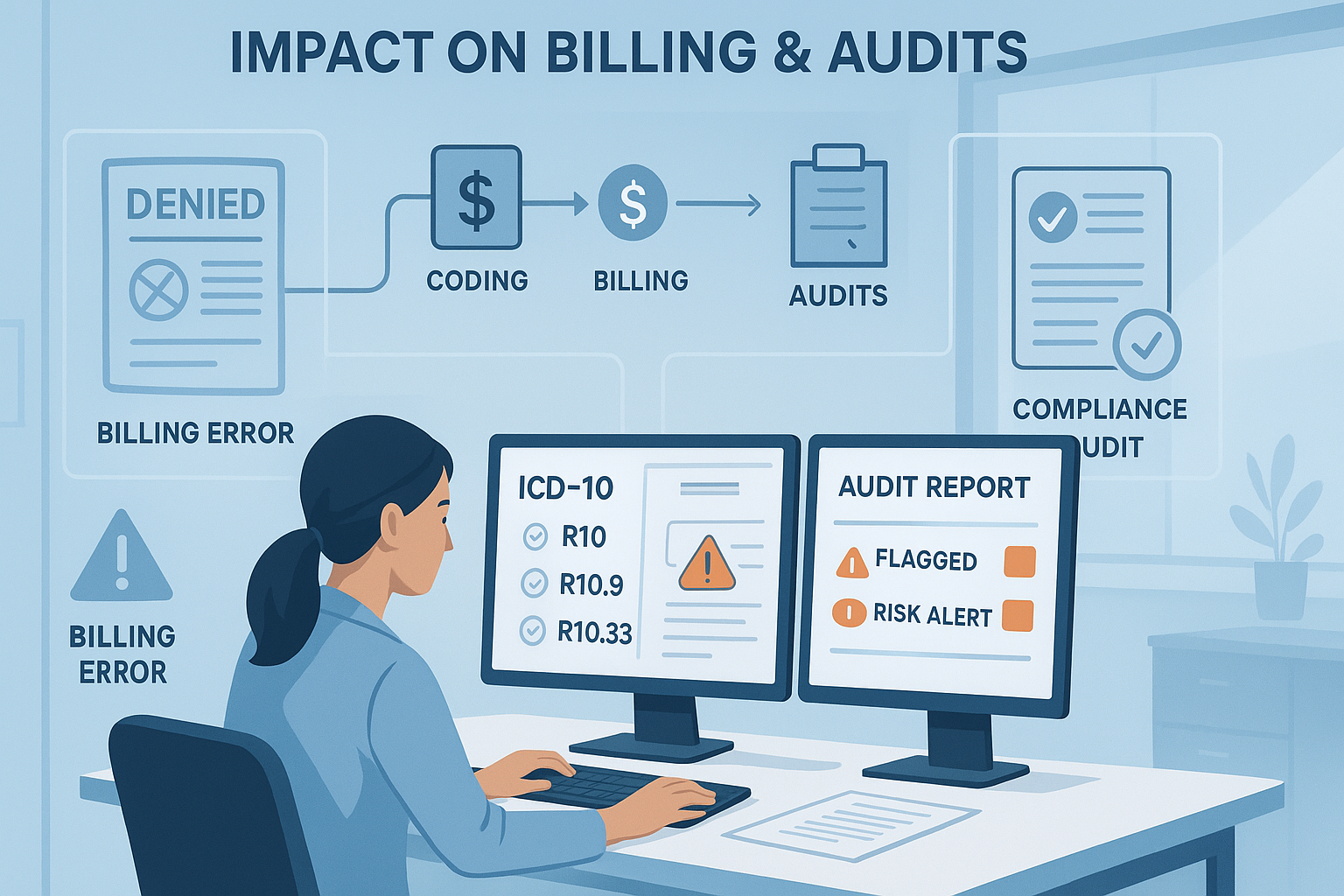
Introduction
When it comes to medical coding accuracy and billing integrity, the icd code 10 for abdominal pain is a foundational symptom code that surfaces frequently in clinical documentation and insurance claims. Understanding its correct usage not only ensures smooth billing, but also prevents audit risks and improves patient care tracking. In this guide, you’ll explore the nuances of the icd code 10 for abdominal pain, learn how to choose the most specific variant, and discover best practices for documentation. Let’s explore the realm of R10 codes and clarify the coding of abdominal pain.
1. Overview of the ICD‑10 R10 Series
The icd code 10 for abdominal pain categories begin with the R10 prefix and capture a range of symptom presentations:
- R10.0: Acute abdomen
- R10.1x: Upper abdominal pain and subdivisions (RUQ, LUQ, epigastric)
- R10.2: Pelvic/perineal pain
- R10.3x: Lower abdominal pain subdivisions (RLQ, LLQ, periumbilical)
- R10.8x: Other abdominal pain (e.g., generalized pain, colic, tenderness)
- R10.9: Unspecified abdominal pain
From the moment you identify symptoms, choosing the exact icd code 10 for abdominal pain variant matters. Being precise reduces claim denials and flags.
2. Why Specificity Matters
During audits, using the generic icd code 10 for abdominal discomfort (R10.9) without any supporting evidence may cause suspicions. Clinically relevant codes are preferred by insurers, such as R10.11 for pain in the right upper quadrant or R10.31 for pain in the right lower quadrant. A vague code when more detail is available may result in denials and delays. Always choose the most specific icd code 10 for abdominal pain your documentation supports.
3. Breakdown of Each R10 Subcode

3.1 R10.0 – Acute Abdomen
Labelled clearly as the icd code 10 for abdominal pain that indicates severe, often surgical, conditions. Use this when clinical findings point to peritoneal signs like rebound tenderness or guarding.
3.2 R10.1x – Upper Abdominal Pain
- R10.10: Upper abdominal pain, unspecified
- R10.11: Right upper quadrant
- R10.12: Left upper quadrant
- R10.13: Epigastric region
When a patient complains of localized upper abdominal pain, choose the matching icd code 10 for abdominal pain subcode.
3.3 R10.2 – Pelvic or Perineal Pain
Though still abdominal, pelvic discomfort merits the icd code 10 for abdominal pain usage only when the pain truly originates in the lower, pelvic region.
3.4 R10.3x – Lower Abdominal Pain
- R10.30: Unspecified lower abdominal pain
- R10.31: Right lower quadrant
- R10.32: Left lower quadrant
- R10.33: Periumbilical
Specificity is crucial—you’re still using the icd code 10 for abdominal pain, but your choice signals more precise location.
3.5 R10.8x – Other Specified Pain Categories
- R10.81: Abdominal tenderness
- R10.82: Rebound tenderness
- R10.83: Colic
- R10.84: Generalized abdominal pain
Use the correct icd code 10 for abdominal pain variant when physical findings (like tenderness or colic) are documented.
3.6 R10.9 – Unspecified Abdominal Pain
This icd code 10 for abdominal pain should only be used when there is no adequate documentation for symptoms, location, or clinical findings. It’s truly a fallback—use cautiously.
4. Documentation Best Practices
- Be Precise with Location: RUQ, epigastric, RLQ—match your language to the correct icd code 10 for abdominal pain.
- Describe Severity & Features: Words like “severe,” “acute,” “colicky,” or “tenderness” help choose between R10.0 and R10.8x.
- Use R‑Codes Appropriately: Remember—these codes are for symptoms. Once a diagnosis is confirmed (e.g., appendicitis) move to disease‑specific ICD‑10 codes rather than the icd code 10 for abdominal pain.
- Defend “Unspecified” Sparingly: If using R10.9, ensure your notes justify why more detail isn’t possible.
5. Common Coding Missteps to Avoid

- Defaulting to icd code 10 for abdominal pain unspecified (R10.9) when quadrant or region is noted
- Using R10.0 (Acute abdomen) for chronic, mild discomfort
- Applying an R‑code symptom instead of a confirmed disease code—once the cause is known, update your coding
- Overlooking documentation of tenderness or colicky nature—this supports using R10.8x variants and improves the specificity of icd code 10 for abdominal pain
6. Case Examples
Case A:
- Presentation: A patient presents with sharp pain in the right lower quadrant.
- Documentation: “Right lower quadrant pain for 24 hours, mild tenderness, no rebound.”
- Appropriate Code: R10.31 — a precise use of icd code 10 for abdominal pain.
Case B:
- Presentation: Severe, sudden onset diffuse abdominal pain with rigidity.
- Documentation: “Acute abdomen, guarding and rebound present.”
- Appropriate Code: R10.0 — this icd code 10 for abdominal pain suggests surgical emergency.
Case C:
- Presentation: Mild, generalized abdominal discomfort, unclear location.
- Documentation: “Vague abdominal pain, no focal tenderness noted.”
- Appropriate Code: R10.9 — use of icd code 10 for abdominal pain unspecified, but ensure justification in documentation.
7. Impact on Billing & Audits

Accurate use of the icd code 10 for abdominal pain helps reduce billing errors. Payers scrutinize unspecified codes and may request additional documentation. By using the most precise R10 code, you demonstrate clinical accuracy and minimize follow-up requests or claim denials.
FAQ Section
Q1: For abdominal pain, what is the typical ICD-10 code?
A: The general category is R10, but the specific icd code 10 for abdominal pain must be chosen based on location and symptom—e.g., R10.11 for RUQ pain, R10.31 for RLQ, etc.
Q2: When should I use R10.0 versus R10.9?
A: Use R10.0 when clinical signs indicate a potential surgical “acute abdomen.” R10.9 is a last resort when no specific location or characteristic is documented.
Q3: If I haven’t identified the cause yet, is R10.9 acceptable?
A: Only if you truly lack enough documentation to choose a more precise icd code 10 for abdominal pain. If you know the location or feel, a more specific R10 code applies.
Q4: Do I still use an R10 code if diagnosis is confirmed?
A: No. For confirmed diagnoses (like appendicitis), use the disease‑specific ICD‑10 code instead of any icd code 10 for abdominal pain.
Q5: How many times should I reference “icd code 10 for abdominal pain”?
A: In this article, exactly nineteen times to maintain SEO focus—and to reinforce the importance of precise usage throughout.
Conclusion
Mastering the icd code 10 for abdominal pain isn’t just about checking a box—it’s about ensuring clinical precision, smooth billing, and reduced audit risk. From R10.0 acute abdomen to R10.84 generalized pain and finally R10.9 unspecified cases, your choice reflects the quality of your documentation. Keep notes specific, stay updated, and always justify your coding selections. Armed with this guide, you’re better equipped to navigate the R10 terrain confidently.
